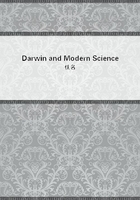
第193章
The second volume of Lyell's "Principles of Geology" was published in January, 1832, and Darwin's copy (like that of the other two volumes, in a sadly dilapidated condition from constant use) has in it the inscription, "Charles Darwin, Monte Video. Nov. 1832." As everyone knows, Darwin in dedicating the second edition of his Journal of the Voyage to Lyell declared, "the chief part of whatever scientific merit this journal and the other works of the author may possess, has been derived from studying the well-known and admirable "Principles of Geology".
In the first chapter of this second volume of the "Principles", Lyell insists on the importance of the species question to the geologist, but goes on to point out the difficulty of accepting the only serious attempt at a transmutation theory which had up to that time appeared--that of Lamarck. In subsequent chapters he discusses the questions of the modification and variability of species, of hybridity, and of the geographical distribution of plants and animals. He then gives vivid pictures of the struggle for existence, ever going on between various species, and of the causes which lead to their extinction--not by overwhelming catastrophes, but by the silent and almost unobserved action of natural causes. This leads him to consider theories with regard to the introduction of new species, and, rejecting the fanciful notions of "centres or foci of creation," he argues strongly in favour of the view, as most reconcileable with observed facts, that "each species may have had its origin in a single pair, or individual, where an individual was sufficient, and species may have been created in succession at such times and in such places as to enable them to multiply and endure for an appointed period, and occupy an appointed space on the globe." ("Principles of Geology", Vol. II. (1st edition 1832), page 124. We now know, as has been so well pointed out by Huxley, that Lyell, as early as 1827, was prepared to accept the doctrine of the transmutation of species. In that year he wrote to Mantell, "What changes species may really undergo! How impossible will it be to distinguish and lay down a line, beyond which some of the so-called extinct species may have never passed into recent ones" (Lyell's "Life and Letters" Vol. I. page 168). To Sir John Herschel in 1836, he wrote, "In regard to the origination of new species, I am very glad to find that you think it probable that it may be carried on through the intervention of intermediate causes. I left this rather to be inferred, not thinking it worth while to offend a certain class of persons by embodying in words what would only be a speculation" (Ibid. page 467). He expressed the same views to Whewell in 1837 (Ibid. Vol. II. page 5.), and to Sedgwick (Ibid. Vol.
II. page 36) to whom he says, of "the theory, that the creation of new species is going on at the present day"--"I really entertain it," but "Ihave studiously avoided laying the doctrine down dogmatically as capable of proof" (see Huxley in "L.L." II. pages 190-195.))After pointing out how impossible it would be for a naturalist to prove that a newly DISCOVERED species was really newly CREATED (Mr F. Darwin has pointed out that his father (like Lyell) often used the term "Creation" in speaking of the origin of new species ("L.L." II. chapter 1.)), Lyell argued that no satisfactory evidence OF THE WAY in which these new forms were created, had as yet been discovered, but that he entertained the hope of a possible solution of the problem being found in the study of the geological record.
It is not difficult, in reading these chapters of Lyell's great work, to realise what an effect they would have on the mind of Darwin, as new facts were collected and fresh observations concerning extinct and recent forms were made in his travels. We are not surprised to find him writing home, "I am become a zealous disciple of Mr Lyell's views, as known in his admirable book. Geologising in South America, I am tempted to carry parts to a greater extent even than he does." ("L.L." I. page 263.)Lyell's anticipation that the study of the geological record might afford a clue to the discovery of how new species originate was remarkably fulfilled, within a few months, by Darwin's discovery of fossil bones in the red Pampean mud.
It is very true that, as Huxley remarked, Darwin's knowledge of comparative anatomy must have been, at that time, slight; but that he recognised the remarkable resemblances between the extinct and existing mammals of South America is proved beyond all question by a passage in his letter to Henslow, written November 24th, 1832: "I have been very lucky with fossil bones; I have fragments of at least six distinct animals...I found a large surface of osseous polygonal plates...Immediately I saw them I thought they must belong to an enormous armadillo, living species of which genus are so abundant here," and he goes on to say that he has "the lower jaw of some large animal which, from the molar teeth, I should think belonged to the Edentata." ("M.L." I. pages 11, 12. See "Extracts of Letters addressed to Prof. Henslow by C. Darwin" (1835), page 7.)Having found this important clue, Darwin followed it up with characteristic perseverance. In his quest for more fossil bones he was indefatigable. Mr Francis Darwin tells us, "I have often heard him speak of the despair with which he had to break off the projecting extremity of a huge, partly excavated bone, when the boat waiting for him would wait no longer."("L.L." I. page 276 (footnote).) Writing to Haeckel in 1864, Darwin says: